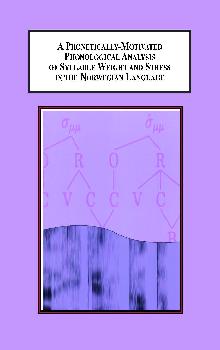This is our backup site. Click here to visit our main site at MellenPress.com
A Phonetically-Motivated Phonological Analysis of Syllable Weight and Stress in the Norwegian Language

| Author: | Lunden, Stephanie L. Anya | |
| Year: | 2010 | |
| Pages: | 216 | |
| ISBN: | 0-7734-3760-6 978-0-7734-3760-9 | |
| Price: | $179.95 | |
Advances a theory of weight in which a syllable shape in a given position is only heavy if it, on average, is sufficiently proportionally longer than a CV (consonant-vowel) in the same position. While the analysis of weight is consistent with the basic tenets of moraic theory, a departure is made from standard moraic theory which takes moras to be prosodic units associated directly to segments.
Reviews
“The grounding of final extrametricality in these independent observations about speech production and perception distinguishes Lunden’s work from other accounts based primarily on theory-internal mechanisms and promises to make this study a seminal contribution to the research program on syllable weight.” – Prof. Matthew Gordon, University of California, Santa Barbara
“. . . this work combines strong theoretical and rigorous experimental analysis to show how generalizations that are better attuned to phonetic realities can dramatically benefit phonology. Lunden’s work lays the foundation for a very interesting program of research.” – Prof. Jaye Padgett, University of California, Santa Cruz
“Building on experimental work with speakers of Norwegian of different age groups, [this study] develops a precise model linking the phonological pattern to its phonetic/functional roots within an overall explanatory theory of phonology. This is a contribution to laboratory phonology in the best sense.” – Prof. Armin Mester, University of California, Santa Cruz
“. . . this work combines strong theoretical and rigorous experimental analysis to show how generalizations that are better attuned to phonetic realities can dramatically benefit phonology. Lunden’s work lays the foundation for a very interesting program of research.” – Prof. Jaye Padgett, University of California, Santa Cruz
“Building on experimental work with speakers of Norwegian of different age groups, [this study] develops a precise model linking the phonological pattern to its phonetic/functional roots within an overall explanatory theory of phonology. This is a contribution to laboratory phonology in the best sense.” – Prof. Armin Mester, University of California, Santa Cruz
Table of Contents
List of Figures
Preface
Acknowledgements
1 Introduction
1.1 CVC weight asymmetry
1 .2 Moraic theory and extrametricality
1.2.1 Moraic theory
1.2.2 Extrametricality and NONFINALITY
1 .2.3 Outstanding issues
1.3 Final lengthening
1.3.1 Influence of final lengthening on syllable weight
1.4 Overview of Norwegian
1.4.1 Phonemic inventory of Norwegian
1.4.2 Quantity and length in Norwegian
1.4.3 Native and loan words
1.4.4 Stress pattern of Norwegian
1.5 Conclusion
2 A phonetic study of length in Norwegian
2.1 Introduction
2.2 Variables pertaining to stress
2.2.1 Dependent variable: duration
2.2.2 Independent variables: stress, position
2.3 Pilot experiment
2.3.1 Methods
2.3.2 Classification of data
2.3.3 Modeling and results
2.4 Follow-up experiment
2.4.1 Methods
2.4.2 Classification of data
2.4.3 Modeling and results
2.5 Conclusion
3 The proportional increase theory of weight
3.1 Introduction
3.2 The categorization of syllable weight
3.2.1 Experiment results with respect to syllable weight
3.2.2 The categorization of syllable weight
3.2.3 Conclusion
3.3 Consequences for moraic theory
3.3.1 The claims of moraic theory
3.3.2 Moras as properties of syllables versus segments
3.3.3 Inherent versus derived length
3.3.3.1 Representing length
3.4 Conclusion
4 An OT analysis of the basic Norwegian stress pattern
4.1 Introduction
4.2 Analysis foundations
4.2.1 Evidence from the lexicon
4.2.2 Evidence from novel words
4.2.2.1 Statistical significance
4.3 Analysis of basic stress pattern
4.3.1 Length in OT
4.3.2 The primacy of final stress
4.3.3 Non-final stress
4.3.3.1 Quantity sensitivity in Norwegian
4.3.4 Proposed ranking
4.4 Comparison to alternative analyses and conclusions
5 Norwegian stress system completed: Exceptions to the basic pattern
5.1 Introduction
5.2 Minor patterns: identification and analysis
5.2.1 Final [s]
5.2.2 Final [s] clusters
5.2.3 Pseudo-polymorphemic words
5.2.4 Final hiatus
5.3 True exceptions: identification and analysis
5.3.1 Final stressed CV
5.3.2 Examples of other exceptions
5.4 Conclusion
6 Extrametricality revisited
6.1 Beyond Norwegian
6.2 Final syllable and final foot extrametricality
6.3 Conclusion
Bibliography
Preface
Acknowledgements
1 Introduction
1.1 CVC weight asymmetry
1 .2 Moraic theory and extrametricality
1.2.1 Moraic theory
1.2.2 Extrametricality and NONFINALITY
1 .2.3 Outstanding issues
1.3 Final lengthening
1.3.1 Influence of final lengthening on syllable weight
1.4 Overview of Norwegian
1.4.1 Phonemic inventory of Norwegian
1.4.2 Quantity and length in Norwegian
1.4.3 Native and loan words
1.4.4 Stress pattern of Norwegian
1.5 Conclusion
2 A phonetic study of length in Norwegian
2.1 Introduction
2.2 Variables pertaining to stress
2.2.1 Dependent variable: duration
2.2.2 Independent variables: stress, position
2.3 Pilot experiment
2.3.1 Methods
2.3.2 Classification of data
2.3.3 Modeling and results
2.4 Follow-up experiment
2.4.1 Methods
2.4.2 Classification of data
2.4.3 Modeling and results
2.5 Conclusion
3 The proportional increase theory of weight
3.1 Introduction
3.2 The categorization of syllable weight
3.2.1 Experiment results with respect to syllable weight
3.2.2 The categorization of syllable weight
3.2.3 Conclusion
3.3 Consequences for moraic theory
3.3.1 The claims of moraic theory
3.3.2 Moras as properties of syllables versus segments
3.3.3 Inherent versus derived length
3.3.3.1 Representing length
3.4 Conclusion
4 An OT analysis of the basic Norwegian stress pattern
4.1 Introduction
4.2 Analysis foundations
4.2.1 Evidence from the lexicon
4.2.2 Evidence from novel words
4.2.2.1 Statistical significance
4.3 Analysis of basic stress pattern
4.3.1 Length in OT
4.3.2 The primacy of final stress
4.3.3 Non-final stress
4.3.3.1 Quantity sensitivity in Norwegian
4.3.4 Proposed ranking
4.4 Comparison to alternative analyses and conclusions
5 Norwegian stress system completed: Exceptions to the basic pattern
5.1 Introduction
5.2 Minor patterns: identification and analysis
5.2.1 Final [s]
5.2.2 Final [s] clusters
5.2.3 Pseudo-polymorphemic words
5.2.4 Final hiatus
5.3 True exceptions: identification and analysis
5.3.1 Final stressed CV
5.3.2 Examples of other exceptions
5.4 Conclusion
6 Extrametricality revisited
6.1 Beyond Norwegian
6.2 Final syllable and final foot extrametricality
6.3 Conclusion
Bibliography
